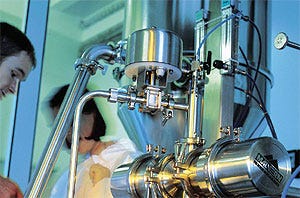December 5, 2006
|
The Malvern Insitec online particle size analyzer |
Online analysis is becoming increasingly widespread for the control of milling processes because moving process analysis from the lab into production can generate considerable cost savings. Conventional quality control methods concentrate on the identification and exclusion of out-of-spec product, whereas real-time, online process analysis enables unsatisfactory plant conditions to be readily identified and process operations to be improved. On the other hand, uncontrolled operation is very much characterized by the personal views of the operators on how to run the mill—but with reticence to push the equipment to the limit. On top of that, modern processes use fewer staff members
to look after multiple operations.
In this article, the milling of metal granulates and foil waste in a ball mill is considered. Here, problems can often arise as a result of poor control of the mill filling process. Because the metal powder is particularly light, and its weight is negligible compared with that of the mill and the milling balls, conventional methods of measuring fill level (such as acoustic measurements and weigh cells) are not appropriate. Overfilling the mill is, therefore, a frequent occurrence that leads to an erratic feed rate to the classifier and poor classifier operation.
To address issues with ball mill performance, the client in this case study installed an automatic online particle size analysis system, integrating it with existing plant equipment for maximum benefit. The system the client purchased was an Insitec from Malvern Instruments, a rugged online particle size analyzer that is designed for use in a process environment. The aim of the project was to reduce the specification span significantly, particularly in midrange particle sizes. Better product quality, improved processability, and more-efficient plant utilization were the ultimate goals. A control strategy had to be developed and implemented.
Before Installation of an Online System
In order to make product with the required specification, material from the mill is pneumatically conveyed to an air classifier. The coarse fraction rejected by the classifier is recycled to the mill. The fines are fed to a sieve and, ultimately, to various storage containers. After filtration, the inert gas is compressed and recycled. Prior to the installation of an online analyzer, product flow around the system was controlled manually using a series of flapper valves. Every few hours, samples of the final product were extracted and analyzed in the lab. Particle size distribution was measured using a laser diffraction instrument. Because of shift patterns, this analysis was often not carried out until the following day. The resulting time lag was a real problem because the plant operator did not have the information required to properly control the particle size of the final product.
Some control of product quality was achieved by varying the classifier’s rotation speed. However, natural variations in raw material feed, especially the rapidly changing material flow rate from the mill to the classifier, caused large fluctuations in classifier operation. This resulted in a product with a relatively broad particle size distribution.
Testing Laser Diffraction
A laser diffraction on-line particle size analyzer was installed in the pneumatic conveying pipe between the classifier and the filter. Since swirling and segregation are a problem in this area, a flow conditioner was installed after the classifier in order to enable reliable and representative sampling. The flow conditioner is a simple steel cross approximately three pipe diameters in length. At about one pipe diameter distance after the flow conditioner, a gas venturi continuously extracts a sample, disperses it, and passes it to the measurement zone of the analyzer. A laser diffraction pattern is measured with an update period of 15 seconds and converted by the associated software into a particle size distribution. As a result, relatively rapid changes in particle size can be tracked effectively. Particle size data, in the form of rolling averages, is fed back into the process control system using a Modbus RTU protocol.
|
Technicians use the Insitec online particle size analyzer. |
The aim of the initial trial was to develop an understanding of the current situation, work out an appropriate strategy for preventing the frequent overfilling of the mill, and achieve a narrow product specification without compromising process efficiency.
Tests were carried out over several days to get a picture of mill performance in the absence of any automated control. These tests showed large fluctuations in particle size distribution that took the operator at least 15 minutes to rectify. During unsteady operation, particle size rose by as much as 50% of the original value, and the standard deviation in Dv(50) was up to 20% of the target value. The coarse fraction, Dv(90) value, occasionally rose to 150% of its initial value. While homogenization of the material during subsequent processing and transportation reduced the impact of these fluctuations on final product quality, the finished material still had a broad particle size distribution.
Occasionally, induced disturbances generate fluctuations in the amount of recirculated material into the mill. Even when raw material feed and classifier speed are constant, changes in the final product fines are visible: With increasing amounts of recirculated material, the product fines decrease and vice versa. The surveyed fluctuations are higher at high raw-material feed rates, which, in the worst case, leads to mill overfilling.
This behavior was explained in 1978, resulting in the development of a control strategy.¹ Since most process fluctuations are caused by an erratic feed rate from the mill to the classifier, it was suggested that particle size should be regulated by controlling the raw material feed rather than the classifier speed. It was theorized that with careful monitoring of the mill and the classifier—that is, using a constant classifier speed and uniform material loading—the particle size distribution should remain constant.
After Installation of an Online Particle Sizing System
Taking into account these principles, an automated control system was designed and installed. The setpoint for the control system is recycle mass flow rate, and the variable parameter is the classifier speed, which automatically varies within limiting values. When the closed-loop control system is active, throughput is increased if the particle size falls short of the target size and decreased if it is too high. The classifier speed regulates itself automatically. This works for all ball milling processes with closed circuits.
In this case, the strategy was slightly modified to allow the raw material feed to fluctuate between two given limits. With the closed-loop control system now in place, material feed varies between these two levels while particle size remains steady. The standard deviation in Dv(50) has been reduced to 10% of the original value, while Dv(90) and Dv(95) values show only small variations when the maximum load limit is reached. Mill throughput is higher, and operators are able
to run the mill more efficiently—closer to its performance limits.
The installation of the online particle sizing system and associated particle concentration/loading measurement after the classifier has facilitated the rapid diagnosis of process problems. Automatic control of the raw material feed has been enabled, and a 75% reduction in the original width of specification has been achieved. Classification is now more selective, resulting in a more effective product split and a narrower particle size distribution.
¹ J Hiettler, “Verfahren zur Regelung von Mahlanlagen,” Zement-Kalk-Gips 2 (1978): 095.
Oliver Schmitt is business line manager—process systems at Malvern Instruments Ltd., Malvern, Worcestershire, UK. He can be reached at
+44 1684 892456 or www.malvern.co.uk.
About the Author(s)
You May Also Like






